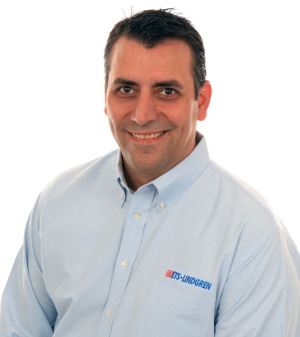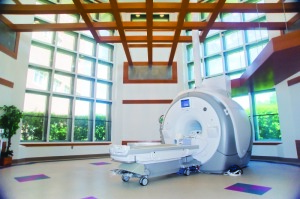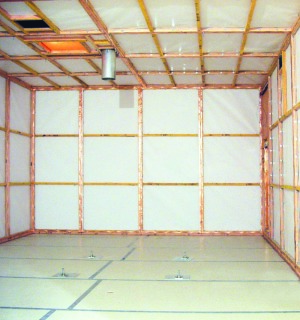From RF shield to detector choice: Designing a safer MR suite
September 21, 2018
by Lauren Dubinsky, Senior Reporter
Even before seeing its first patient, there’s already much to say about the safety, or lack thereof, in a new MR suite.
Things like radiofrequency (RF) shielding and ferromagnetic detectors may not be top-of-mind on a daily basis, but it’s the presence of these things that helps ensure the MR environment is safe and secure at all times.
Understanding the different options for these things and how they compare is not always easy. Here we look at different RF shield types and recent advancements in ferromagnetic detector technology, as well as how to avoid MR adverse events and problems during the shield design process.
Choosing the right metal for your shield
One of the biggest decisions a facility will make when building an MR suite is whether to choose a copper, aluminum or galvanized steel shield. HCB News discussed the pros and cons of each shield type with three RF shield vendors.
ETS-Lindgren uses annealed copper as its RF shielding metal of choice because it’s more conductive than the other metals. The only metal that has a higher conductivity rating is pure silver.
The company also prefers copper because it corrodes into copper oxide, which is electrically conductive.
“Corrosion at the panel joints made of copper will have little, if any, effect on the conductivity of the panel joints and thus maintains the shielding effectiveness,” said David Geiger, vice president of sale for the Americas at ETS-Lindgren.
The primary RF conductor with a galvanized steel shield is the zinc coating on the base steel plate. Since zinc corrodes into zinc oxide, which is ceramic and electrically inert, Geiger said the overall shielding effectiveness will be compromised due to a reduction in surface conductivity.
However, some in the industry are committed to the benefits of steel over copper and maintain that the metal sometimes has an undeservedly bad reputation when it comes to shielding construction.
“There is a notion out there that if you have an MR room you have to have copper. A lot of people think that way, but that is not true,” said Howard Newman, vice president of Universal Shielding. “We do galvanized steel rooms predominately and they work just fine for all of the MR rooms.”
Universal Shielding enclosures are designed to be free-standing or supported from the parent room ceiling. According to Newman, the company has installed shield enclosures that are still in use 35 to 40 years later.
Galvanized steel yields certain advantages over copper when it comes to shielding. For example, Newman said, it provides some degree of magnetic shielding whereas copper does not.
Aluminum is another viable option when setting out to build an MR suite. As with steel, it is usually cheaper to build an aluminum shield than one with copper.
Cristiano Villa, president of Istra Corporation, exclusively uses aluminum because its attenuation is high and it’s strong enough to form a self-standing structure. “Instead of having shielding that needs to be soldered and adhered to the parent building we designed shielding that would be independent from the parent room and have zero wood in its structure,” he said.
Having it so the shield is independent from the parent rooms allows for a faster installation. In addition, said Villa, eliminating wood makes the shield water-resilient – if wood is used and a pipe breaks above or there is flooding from a storm, the facility will have to redo the RF shielding.
Good communication is crucial
Doing your homework before buying a shield is just as important as doing your homework before buying an MR scanner – and in both cases there is a lot more to consider than the price on the sticker. A smart investment requires understanding the total cost of ownership and resisting the urge to cut corners.
“Oftentimes, when new MR rooms are being constructed, it appears that choosing a company that provides cheaper RF shielding is a viable solution,” said Villa. “Will choosing a product that costs less today save you money in the future? Chances are, if it is an inferior product the answer would be no.”
When choosing an RF shielding company, a facility needs to take into account all that a company can and should provide for them. Upfront costs can often blur decision-making, which can lead to problems later on.
In many cases, the facility itself will not be working directly with the shielding company. Instead, a general contractor may be commissioned to take care of that and other construction aspects of the suite. In these situations, clear communication with the contractor is essential to avoid unexpected problems down the line.
“Sometimes there isn’t a foresight of planning between the end users to explain exactly what they want,” said Michael Newman, vice president of operations at Universal Shielding, describing a worst case scenario. “The contractor lowballs the price and gives it out to the cheapest company, and the hospital is done a disservice because they are not getting a quality product.”
In some cases, the facility will want to make changes after the MR suite is already built.
“We work with many customers that are frustrated or angry with the end result because they had not gotten involved in the process of design or specifying product selections,” said Geiger.
He added that many times they have expressed that there wouldn’t have been a problem if they had 10 to 15 minutes to discuss their requirements with the shielding company instead of leaving important decisions to the contractor and/or architect.
As expensive as construction of an RF shield may be, in the long run it’s more expensive to have a low-quality shield start deteriorating ahead of schedule. Shielding experts agree, crunching the numbers and figuring out exactly what you’re going to get for your money is the key to creating an MR suite that your facility is going to be satisfied with in the long-run.
Smarter ferromagnetic detectors
Although less permanent than RF shields, ferromagnetic detectors are imperative to ensuring a safe MR environment. These detectors ensure that metal objects don’t get within range of the MR magnet, which can be a costly – and sometimes fatal – mistake.
The technology has been around for a long time, but in recent years it’s become much more sophisticated. One area of weakness where progress has been made is with alert fatigue and developing systems that won’t set off unnecessary alarms.
“Many of the doors in the MR room are somewhat ferromagnetic, so the act of opening a door could set off the detector,” said Keith Kopp, president of Kopp Development. “We have software and hardware that basically suppresses that sort of thing.”
The company’s FerraAlert Halo II Plus detector system can also determine if something ferromagnetic is actually approaching the magnet room or just passing by it. For example, it ignores a gurney that is passing by the doorway, but if it turns and heads toward the doorway then the system will sound the alarm.
FerraAlert Halo II Plus can also determine the location of the ferromagnetic object, which can save the facility a great deal of time.
“Rather than having to do a complete pat-down on someone, the system will point to the right pocket, for example,” said Kopp. “Showing locations helps to not slow down the process.”
New Joint Commission requirements order facilities to log all ferromagnetic incidents whether they result in injury or not. Kopp recently developed a comprehensive image capture solution and diagnostic software package that helps facilities generate reports for those incidents.
Mednovus, which manufactures the SAFESCAN Target Scanner, has focused its efforts on making it more sensitive so it’s better able to distinguish between ferromagnetic and non-ferromagnetic objects.
Kemp Massengill, president and quality assurance director at Mednovus, described the tool as offering superior sensitivity, which can be credited in part to its handheld design.
“Since the signal from a ferromagnetic threat decreases to the cube of the distance, having the sensors close to the threat is obviously important,” he said. “For gurney-bound patients, the signal in the centers of pillars set at a doorway of 48 inches is very small.”
Another ferromagnetic detector manufacturer offering a handheld solution to eliminate adverse safety events in the MR suite is Aegys. The control interface for Aegys’ Ceia PD240CH Handheld detector allows the user to choose if they want an acoustic or vibration alarm, a functionality built with the patient experience in mind.
“The vibration mode of detection versus audible alarms means that patient agitation is mitigated during the important pre-imaging screening process,” said Joseph Barwick, co-founder of Aegys.
Adverse events and spatial gradients
The rate of MR adverse events reportedly increased by 500 percent from 2000 to 2009, while scan utilization only increased by 114 percent. This research raises the questions: what is accounting for it and is this trend continuing?
“The biggest contributing factor to the increase is the steepness of the spatial gradient of the MR magnet,” explained Kopp.
If someone is holding a scalpel, he explained, they might feel a tug with older MR magnets as the magnetic field got stronger. However, the magnetic field with newer systems is more compact, so they may not feel anything as they walk into the room and then suddenly the scalpel is pulled from their hand.
The MR manufacturers want to contain that magnetic field inside the bore because it generates much better image quality. But on the operational side, it has become challenging for the technologists to read the pull of the magnetic field.
“It can be very dangerous. Let’s say someone has something in their hand and they are five feet away from the magnet – it accelerates as it gets closer to the magnet,” said Kopp. “If someone is near or in the bore, it’s going to be traveling somewhere between 40 and 50 miles an hour whatever is coming at you.”
Every few months it seems there’s a new tragedy making headlines. In early 2018, a 32 year old man died in India as he carried his relative’s oxygen tank into the MR environment. But even small objects can do significant damage – in one case, someone’s hairpin went up a patient’s nose and was jammed in their sinus cavity.
“Based upon direct feedback from the community, it is pretty apparent that the upward trend in adverse events is continuing,” said Barwick. “While there are mechanisms and tools that encourage and aid in the reporting of adverse events, the sheer number of those events are tied to trends everyone is experiencing in imaging.”
Those trends include alarm fatigue, improper or unestablished protocols, reductions in staff size, greater presence of contraindicated devices, and complications associated with patient property or clothing.
What can a facility do?
To counteract this problem, Kopp suggests following the American College of Radiology’s Guidance Document on MR Safe Practices for 2013. The comprehensive 30-page document is free online and provides information on everything from MR site construction considerations to scanning safety and emergency preparedness.
“The studies that I’ve seen indicate that if the ACR guidelines are followed, it would cut out the vast majority of that 500 percent,” said Kopp.
Massengill believes that MR Medical Director and/or MR Safety Officer educational courses play a role in reducing the number of adverse events.
“Far and away, the most important ingredient for a safe MR environment is an intelligent, dedicated MR technologist who truly cares about the safety of the patient,” he said.
When things are going smoothly it might be easy for providers to forget that there is significant risk with every single MR scan, and this risk must be recognized. As with many professions in dangerous environments, complacency is one of the biggest challenges to a strong safety record.
“You need people who know what they are doing, so the staff has to be trained and there are a number of things that have to be built into the facility,” Kopp said. “Not only the physical layout of the facility, but also the policies and procedures that implement the recommendations from ACR and JC. All of these things play together to help the whole safety environment.”
Things like radiofrequency (RF) shielding and ferromagnetic detectors may not be top-of-mind on a daily basis, but it’s the presence of these things that helps ensure the MR environment is safe and secure at all times.
Understanding the different options for these things and how they compare is not always easy. Here we look at different RF shield types and recent advancements in ferromagnetic detector technology, as well as how to avoid MR adverse events and problems during the shield design process.
Choosing the right metal for your shield
One of the biggest decisions a facility will make when building an MR suite is whether to choose a copper, aluminum or galvanized steel shield. HCB News discussed the pros and cons of each shield type with three RF shield vendors.
ETS-Lindgren uses annealed copper as its RF shielding metal of choice because it’s more conductive than the other metals. The only metal that has a higher conductivity rating is pure silver.
The company also prefers copper because it corrodes into copper oxide, which is electrically conductive.
“Corrosion at the panel joints made of copper will have little, if any, effect on the conductivity of the panel joints and thus maintains the shielding effectiveness,” said David Geiger, vice president of sale for the Americas at ETS-Lindgren.
The primary RF conductor with a galvanized steel shield is the zinc coating on the base steel plate. Since zinc corrodes into zinc oxide, which is ceramic and electrically inert, Geiger said the overall shielding effectiveness will be compromised due to a reduction in surface conductivity.
However, some in the industry are committed to the benefits of steel over copper and maintain that the metal sometimes has an undeservedly bad reputation when it comes to shielding construction.
“There is a notion out there that if you have an MR room you have to have copper. A lot of people think that way, but that is not true,” said Howard Newman, vice president of Universal Shielding. “We do galvanized steel rooms predominately and they work just fine for all of the MR rooms.”
Universal Shielding enclosures are designed to be free-standing or supported from the parent room ceiling. According to Newman, the company has installed shield enclosures that are still in use 35 to 40 years later.
Galvanized steel yields certain advantages over copper when it comes to shielding. For example, Newman said, it provides some degree of magnetic shielding whereas copper does not.
Aluminum is another viable option when setting out to build an MR suite. As with steel, it is usually cheaper to build an aluminum shield than one with copper.
Cristiano Villa, president of Istra Corporation, exclusively uses aluminum because its attenuation is high and it’s strong enough to form a self-standing structure. “Instead of having shielding that needs to be soldered and adhered to the parent building we designed shielding that would be independent from the parent room and have zero wood in its structure,” he said.
Having it so the shield is independent from the parent rooms allows for a faster installation. In addition, said Villa, eliminating wood makes the shield water-resilient – if wood is used and a pipe breaks above or there is flooding from a storm, the facility will have to redo the RF shielding.
Good communication is crucial
Doing your homework before buying a shield is just as important as doing your homework before buying an MR scanner – and in both cases there is a lot more to consider than the price on the sticker. A smart investment requires understanding the total cost of ownership and resisting the urge to cut corners.
“Oftentimes, when new MR rooms are being constructed, it appears that choosing a company that provides cheaper RF shielding is a viable solution,” said Villa. “Will choosing a product that costs less today save you money in the future? Chances are, if it is an inferior product the answer would be no.”
When choosing an RF shielding company, a facility needs to take into account all that a company can and should provide for them. Upfront costs can often blur decision-making, which can lead to problems later on.
In many cases, the facility itself will not be working directly with the shielding company. Instead, a general contractor may be commissioned to take care of that and other construction aspects of the suite. In these situations, clear communication with the contractor is essential to avoid unexpected problems down the line.
“Sometimes there isn’t a foresight of planning between the end users to explain exactly what they want,” said Michael Newman, vice president of operations at Universal Shielding, describing a worst case scenario. “The contractor lowballs the price and gives it out to the cheapest company, and the hospital is done a disservice because they are not getting a quality product.”
In some cases, the facility will want to make changes after the MR suite is already built.
“We work with many customers that are frustrated or angry with the end result because they had not gotten involved in the process of design or specifying product selections,” said Geiger.
He added that many times they have expressed that there wouldn’t have been a problem if they had 10 to 15 minutes to discuss their requirements with the shielding company instead of leaving important decisions to the contractor and/or architect.
As expensive as construction of an RF shield may be, in the long run it’s more expensive to have a low-quality shield start deteriorating ahead of schedule. Shielding experts agree, crunching the numbers and figuring out exactly what you’re going to get for your money is the key to creating an MR suite that your facility is going to be satisfied with in the long-run.
Smarter ferromagnetic detectors
Although less permanent than RF shields, ferromagnetic detectors are imperative to ensuring a safe MR environment. These detectors ensure that metal objects don’t get within range of the MR magnet, which can be a costly – and sometimes fatal – mistake.
The technology has been around for a long time, but in recent years it’s become much more sophisticated. One area of weakness where progress has been made is with alert fatigue and developing systems that won’t set off unnecessary alarms.
“Many of the doors in the MR room are somewhat ferromagnetic, so the act of opening a door could set off the detector,” said Keith Kopp, president of Kopp Development. “We have software and hardware that basically suppresses that sort of thing.”
The company’s FerraAlert Halo II Plus detector system can also determine if something ferromagnetic is actually approaching the magnet room or just passing by it. For example, it ignores a gurney that is passing by the doorway, but if it turns and heads toward the doorway then the system will sound the alarm.
FerraAlert Halo II Plus can also determine the location of the ferromagnetic object, which can save the facility a great deal of time.
“Rather than having to do a complete pat-down on someone, the system will point to the right pocket, for example,” said Kopp. “Showing locations helps to not slow down the process.”
New Joint Commission requirements order facilities to log all ferromagnetic incidents whether they result in injury or not. Kopp recently developed a comprehensive image capture solution and diagnostic software package that helps facilities generate reports for those incidents.
Mednovus, which manufactures the SAFESCAN Target Scanner, has focused its efforts on making it more sensitive so it’s better able to distinguish between ferromagnetic and non-ferromagnetic objects.
Kemp Massengill, president and quality assurance director at Mednovus, described the tool as offering superior sensitivity, which can be credited in part to its handheld design.
“Since the signal from a ferromagnetic threat decreases to the cube of the distance, having the sensors close to the threat is obviously important,” he said. “For gurney-bound patients, the signal in the centers of pillars set at a doorway of 48 inches is very small.”
Another ferromagnetic detector manufacturer offering a handheld solution to eliminate adverse safety events in the MR suite is Aegys. The control interface for Aegys’ Ceia PD240CH Handheld detector allows the user to choose if they want an acoustic or vibration alarm, a functionality built with the patient experience in mind.
“The vibration mode of detection versus audible alarms means that patient agitation is mitigated during the important pre-imaging screening process,” said Joseph Barwick, co-founder of Aegys.
Adverse events and spatial gradients
The rate of MR adverse events reportedly increased by 500 percent from 2000 to 2009, while scan utilization only increased by 114 percent. This research raises the questions: what is accounting for it and is this trend continuing?
“The biggest contributing factor to the increase is the steepness of the spatial gradient of the MR magnet,” explained Kopp.
If someone is holding a scalpel, he explained, they might feel a tug with older MR magnets as the magnetic field got stronger. However, the magnetic field with newer systems is more compact, so they may not feel anything as they walk into the room and then suddenly the scalpel is pulled from their hand.
The MR manufacturers want to contain that magnetic field inside the bore because it generates much better image quality. But on the operational side, it has become challenging for the technologists to read the pull of the magnetic field.
“It can be very dangerous. Let’s say someone has something in their hand and they are five feet away from the magnet – it accelerates as it gets closer to the magnet,” said Kopp. “If someone is near or in the bore, it’s going to be traveling somewhere between 40 and 50 miles an hour whatever is coming at you.”
Every few months it seems there’s a new tragedy making headlines. In early 2018, a 32 year old man died in India as he carried his relative’s oxygen tank into the MR environment. But even small objects can do significant damage – in one case, someone’s hairpin went up a patient’s nose and was jammed in their sinus cavity.
“Based upon direct feedback from the community, it is pretty apparent that the upward trend in adverse events is continuing,” said Barwick. “While there are mechanisms and tools that encourage and aid in the reporting of adverse events, the sheer number of those events are tied to trends everyone is experiencing in imaging.”
Those trends include alarm fatigue, improper or unestablished protocols, reductions in staff size, greater presence of contraindicated devices, and complications associated with patient property or clothing.
What can a facility do?
To counteract this problem, Kopp suggests following the American College of Radiology’s Guidance Document on MR Safe Practices for 2013. The comprehensive 30-page document is free online and provides information on everything from MR site construction considerations to scanning safety and emergency preparedness.
“The studies that I’ve seen indicate that if the ACR guidelines are followed, it would cut out the vast majority of that 500 percent,” said Kopp.
Massengill believes that MR Medical Director and/or MR Safety Officer educational courses play a role in reducing the number of adverse events.
“Far and away, the most important ingredient for a safe MR environment is an intelligent, dedicated MR technologist who truly cares about the safety of the patient,” he said.
When things are going smoothly it might be easy for providers to forget that there is significant risk with every single MR scan, and this risk must be recognized. As with many professions in dangerous environments, complacency is one of the biggest challenges to a strong safety record.
“You need people who know what they are doing, so the staff has to be trained and there are a number of things that have to be built into the facility,” Kopp said. “Not only the physical layout of the facility, but also the policies and procedures that implement the recommendations from ACR and JC. All of these things play together to help the whole safety environment.”






